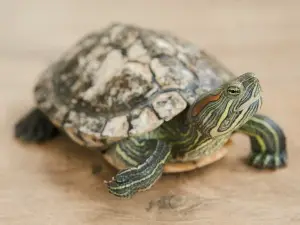
If you know your turtle to have a smooth shell, and its shell suddenly starts to develop dents on it, then you’d understandably be worried.
This article looks into why your turtle’s shell may have dents in it.
Table of Contents
Dents in turtle shell:
A change in your turtle’s appearance will understandably worry you, others may not notice the dents in your pet’s shell but you likely will.
Here is why there may be dents in your turtle’s shell:
Injury:
If your animal recently fell from a high height or collided with something then the fall or collision may have caused your pet to develop a dent, or rather some dents, in the shell.
What to do:
Examine the animal and its behavior before deciding on the next steps.
If your pet is still active is eating normally and isn’t acting out of the ordinary then the little animal should be fine.
If your pet is starting to show signs of distress, or is acting oddly all of a sudden, then taking the animal to the vet is recommended.
Note: just because your pet’s shell is dented and not broken does not mean that there isn’t anything wrong, it may simply mean that there is damage under the shell.
You’d need to take your pet to the vet in this case.
Metabolic bone disease:
Another reason why your turtle may have dents in its shell may be because the animal has a condition called metabolic bone disease.
Turtles with this condition develop deformities in their body, like dents in the shell.
This is a concern that usually occurs in older turtles who have issues with their nutrition or who are in a less-than-optimal environment.
A lack of calcium in your pet can cause this condition and thus the dents in the animal’s shell.
Too much phosphorus can also cause this condition.
The turtle’s body likes a balance of phosphorus and calcium in the blood. If the animal has too much phosphorous in the blood then the body will remove calcium from the animal’s bones (the shell included). causing the shell to become weak in some places and develop dents.
This calcium in the bones will be sent to the bloodstream.
Another cause of this condition is insufficient vitamin D, this happens when the animal doesn’t get enough UVB exposure. UVB exposure helps the animal produce vitamin D.
What to do:
If you think that your pet has this condition then changing the bulbs in your pet’s basking area and adding more calcium into its diet will also help.
The UVB bulb’s output will decline the longer you use them, for this reason, it is advised that you change these bulbs every 5/6 months.
Tube bulbs have a longer lifespan but still need to be replaced every couple of years or so.
Adding calcium to your pet’s diet should also help. Add a pinch of calcium powder to your pet’s food 3 times a week.
Giving your turtle some snails to eat is also helpful as snail shells are rich in calcium and their meat is a good food source.
If you enjoyed this article then you may also be interested in other turtle/tortoise related articles. Here are some articles that you may be interested in: Why Is My Turtles Skin Red On The Sides?, Turtle Bleeding From Mouth, Turtle Shell Soft Around Edges, Deformed Turtle Shell Care, Deformed Turtle Shell, My Turtles Tail Got Bitten Off, Turtle Missing Part Of Shell, Why Is My Turtle Losing His Shell?

